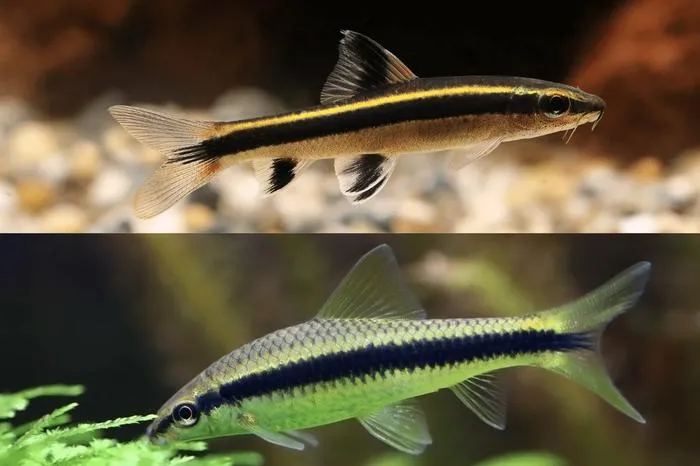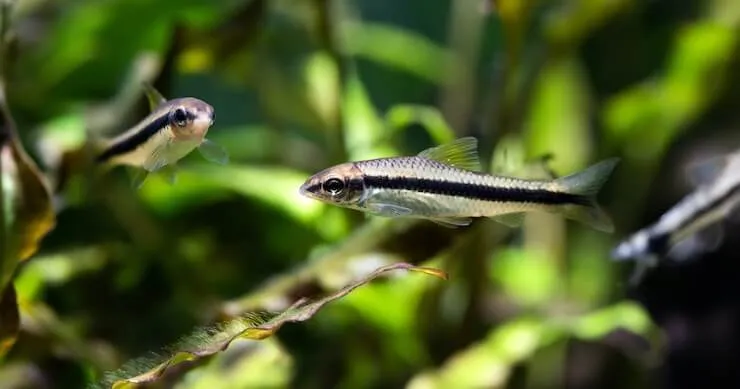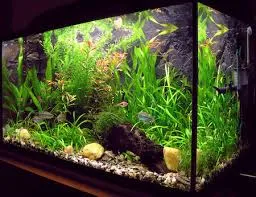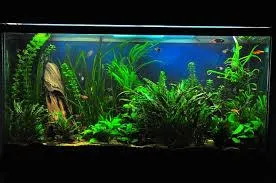Siamese is a beautiful creature with social and active behavior. That’s why they can live in a large group and survive alone. They can eat anything, and you will not face any trouble with their eating habits.
Siamese algae eaters will play a vital role in your tank. They will help with cleanliness and take part in a tidy tank. These fishes keep the water clean and save it from algae. I have an aquarium with a couple of Siamese which keeps my tank neat and clean.
This fish will prove an excellent addition to your tank due to its peaceful behavior; it will emerge with the community in the aquarium. They may be a good pick for the beginner. Siamese algae eaters should not confuse the flying fox; they are different.
Siamese Algae Eater Overview
| Scientific Name | Crossocheilus oblongus |
| Common Name | Siamese Algae Eater, Scarfing Down Algae |
| Origin | Mainland Southeast Asia |
| Family | Cyprinidae |
| Caretaking | Easy |
| Body Size | Up to 6 inches |
| Feeding habit | Omnivore |
| Movement Type | Less-aggressive |
| Behavior | Peaceful |
| Lifespan | Up to 10 years |
| Temperature Range | 24° – 26° C |
| Minimum Tank Size | 20 gallons |
| pH Range | 6.5 – 8.0 |
| Water type | 5 – 20 dH |
| Breeding | Easy |
| Compatibility | Peaceful community fish |

Origin and Habitat
Siamese algae eater is a freshwater fish and belongs to the Cyprinidae family, and its scientific name is Crossocheilus oblongus. Carps are also from this family, so you may see a close relationship among them.
The origin of this fish is South Asia, Malaysia, and Thailand. However, these days this species is also bred across the world to increase the beauty of the aquarium. The popularity of this fish is due to its algae-eating, and they are considered the best type of algae eaters for the aquarium community. They rush and can cover the whole tank quickly.
The rush movement of this fish keeps your tank active and is also suitable for algae. The other algae eater, such as the nerite snail, cannot move like this. For beginners, Siamese is a good choice because it will keep your tank clean, and the processes of cleaning will make it easy for you.
But at the same time, just like the other fishes, Siamese also produce waste, and overstocking may create a mess for you instead of cleaning because I have that kind of experience once.
Their origin is from South Asia, and you can find Siamese algae eaters in streams and densely planted rivers. The habitat preference is just like the Asian Carp so you can associate them.
These algae eaters spend their time hiding in these shelters and searching the water surface for food. However, they also sink to the bottom of the river to search for food. But all of these events rarely occur; otherwise, Siameses like to stay in their shelters and tend to find food around them. They rarely venture up to the surface for food searching, and only the natural habitat is ideal for them.
Physical Appearance
Siamese looks like a tiny jet plane, and this smooth and sleek body shape helps them swim even in strong currents. The other fishes have swim bladders, but Siamese doesn’t contain this; their streamlined body help them to float in the water in high currents. That’s why they remain in constant motion for struggle.
There are two small barbels on their upper lip in all species, but there are two longest barbels in Red algae eaters. These barbels are very helpful in finding the tiny prey rushing around the substrate. They can also detect shifts in water currents and chemical changes through these barbels.
The snout is slightly upturned or pointed and helps them scratch the algae from the surface. They have colorless and translucent fins, and the fins are six in number.
You can see a triangular dorsal fin and a pair of pectoral fins which sit just below the gills, and on the abdomen, there is a pelvic fin. And you can see their anal fin at the end of the tail and between the pelvic fin and caudal fin.
How big do Siamese algae eaters get? A typical Siamese algae eater size is 2 to 2.5 inches, but it can reach 5 to 6 inches. There is a black horizontal stripe from eyes to tail, and these stripes help them camouflage with the surroundings. You may face difficulty finding them in between the rocks. However, other possible colors are tan, tawny yellow, and reddish-brown.
It is impossible to differentiate between males and females until the fish reaches the age of three years. There is a difference noticeable in their size as the female fish is more extensive than the male fish.
Siamese Algae Eater Aggressive Behavior
Siamese algae eaters fish are calm and peaceful in temperament. Due to their dynamic and relaxed behavior, they can easily adjust to the aquarium community. I also noticed that they will not create any mess if you have a large variety of fish in your tank.
Siamese always moves around the tank and consider social fish, and they get along with the other water creatures and easily camouflage in the environment. Siamese algae eater’s aggressive nature is rarely seen in the aquarium.

However, some cautions should remain in mind if any person wants to have this fish in their collection. As we explain, that siamese doesn’t have any swim bladders; that’s why it remains in motion and needs some safe places for hiding at the bottom of the tank. When it becomes tired and stays alone, it looks for someplace for hiding.
You can provide them with places for hiding by adding caves and clumps of plants in your tank. You can also build caves or holes with stones and rocks. In this way, you can not only add decoration to your tank but also fulfill the needs of the fish. These places give these fish loneliness when they are tired and want to spend some time in peace for rest.
However, the behavior of Siamese algae eaters is active and social, but sometimes they need rest. But mostly, you will see them ready to go, and you can see them eating algae at the bottom of the tank and from the walls. This behavior makes it an exciting fish instead of the other shy creatures.
Before having this fish, you should understand that it’s not an aggressive fish, but its constant motion throughout the tank may disturb the other mates in the aquarium. Their continuous motion in any other fish’s area may cause create a problem. You can control it by adding some extra places for hiding and arranging a prominent swimming area.
If you see any change in the siamese behavior, notice the condition and determine which fish or creature creates a mess for this peaceful and relaxed fish. Carefully monitor the situation and find the problem, and it is the best solution to provide them with enough space for hiding and a wide area for swimming.
These fish are territorial and like to live in their kind. So it is good to keep it single or if you want to keep them in a group, then keep five or more in a group. In this way, they can prevent the other fish from claiming the tank area, and the wild situation will not occur.
Siamese Algae Eater Lifespan
Mostly siamese algae eaters like to live together, but they can live solo. If you have two siamese together, then they will make their territory. They will create their own family when they become mature.
The lifespan of a true Siamese Algae Eater is outstanding. They can live a long life in favorable conditions, up to 10 years. It is a good life duration for any hobbyist and will be an excellent addition to your collection in your tank. Siamese Algae eaters lifespan depends on the care they receive in the tank.
Siamese Algae Eater Care Sheet
The sand is safe and suitable substrate for siamese because they live in the bottom of the tank and have sensitive skin. The stony substrate may damage or scratch sensitive skin and affect barbels. So the sand substrate is safe for them.
For providing them home-like feeling, add more plants. These plants shelter them and clear the water and maintain oxygen in it.

These fish may nibble on plants if they can not find other food. So keep them well-fed and take care of them if you want to save your plants. You can use the plants like hornwort as they grow very fast if any part is damaged or eaten by fish.
Bottom-dwelling fish want to hide away from their other tank mates. For this create caves and holes so they can escape from their fellows. They are not territorial, so they pay no attention to who goes where they only need some space away from others.
Fish can jump, but not all kinds of fish can do this action. As far as the siamese algae eaters are active and quick, these qualities make them able to jump from the water. So it is recommended that you place a lid on the tank to avoid and fatal escape attempt.
Siamese algae eater temperature requirement is moderate. The water temperature should remain in the range of 75 to 79F, and the hardness of the water will be 5 to 20 dH. These conditions will be helpful in their lifespan.
Moreover, the pH of the water should remain between 6.5 to 7.0, but it is slightly negotiable, roughly from 6.0 to 8.0.
There are no specific needs for water flow. It seems a little bit surprising as they live in rivers water. However, they live in the river bed where the water current is shallow so that they can survive in normal conditions.
Siamese Algae Eater Diet & Food
Their name shows clearly about their food. They can eat algae, plant matter, and vegetation, but it doesn’t mean that they are herbivores. They are scavengers, and they can eat anything they find in their surroundings, such as dead fish and insects.

So it is easy to feed them in the aquarium because they can eat whatever you provide them in the tank. Siameses are not fussy in their eating habits. You can feed them with pellet foods, flakes, algae wafers, and living food. For example, you can provide them with brine shrimps and bloodworms, and the frozen food will also work for them.
As algae eaters are bottom-dwelling fish, the sinking pellets are good food. They will like to search for their nutrition from the bottom substrates.
They have algae and plants in the tank for feeding, so avoid overfeeding them. It may cause a problem. But sometimes algae eaters stop eating algae as they have some other kind of food that is more delicious than algae. You give them different food if you keep adding too much.
Full-grown Siamese Algae eaters can eat anything, even the whole day. So be careful about feeding to avoid any problems and give them enough food that can efficiently finish in a couple of minutes.
Siamese Algae Eater Tank Size
Reticulated Siamese Algae Eater needs more space, and 20 gallons are enough for one fish, but if you add second fish, then add ten gallons per fish in our tank. You can place more than one siamese fish in your aquarium. They will not disappoint you with the behavior in a group of 4 to 6.

But it doesn’t mean that you keep the Siamese algae eater group. It is good to have it alone or in pair. Siamese algae eater tank size remains dependent on several factors like their total number, tank mates, and plants.
Substrate
Siamese algae eater is bottom-dwelling and spends most of the time in the bottom of the tank, so it is good to have sand as a substrate. If you use stones and rocks as substrate, sensitive skin and barbells may damage.
Filter Type
Although siamese is still algae eaters, there is a need for a filter. The addition of siamese in the tank means one more fish and an increase in fish waste, so use a strong filter in the tank. All nitrites need removal from the water, so the other creature in your tank will save from toxic material.
Lighting
The lights should be very bright and strong enough to reach the bottom of the tank because the siamese algae eaters remain at the bottom of the tank. So there is a need for better light conditions for searching for food, even in the base substrate.
Nitrogen Requirement
Nitrites in the tank may create a problem for fish to prevent them from collecting in the water. Install a better filtration system so that the toxic material will not stay in the tank and clean the water. There is also a need to change the water once a week for the better health of your fish.
Plants
Siamese algae eaters are herbivores, and if they don’t get the feed properly, they can even eat your plants in the tank. If you want to save your plants, keep them providing in a good way and also use plants like hornwort is suitable because it will grow fast than the other aquatic plants.
Siamese Algae Eater Tank Mates
Siamese algae eater is a peaceful and social fish, and it means that there is a massive list of companions. They will make a good combination with other tank fellows.

We know that these fish live at the bottom of the tank. So keep in consideration what else will be living there. For example, Redtail sharks can be a good option as they can handle others very well to protect their area. The peaceful algae eaters will not win this battle at all.
As Siamese algae eater tank mates, you can choose a peaceful bottom-dweller for your aquarium. One of the best options is Corydoras, and many species belong to this family.
If you pick up the fish living in the other tank area, there will be no dispute among them about territory. There is a wide range of this kind of fish. Please don’t add any aggressive fish to your tank; otherwise, it may eat your algae eater. You can consider other species that are peaceful such as angelfish.
Due to their small size and nonaggressive behavior, the Tetras, danios, and guppies will be a good choice. Big size gouramis and barbs are also better options as they are not aggressive.
You can also some other creature instead of fish. Other water animals also add as a mate to your tank. The shrimp and snails are one of the best options for this addition.
However, adding shrimp and snail will give you a different experience, and you can also see the behavior of these mates with each other. They will also help you to maintain the biological condition of your aquarium. But don’t overstock your aquarium.
Siamese Algae Eater Disease
If we talk about the disease of siamese algae eaters, then there is no specific health issue, but it doesn’t mean they cannot become ill.
Ichthyophthirius multifiliis, known as “ich,” is a common disease, and you will see small white dots on their body. But most disorders give off signs and may be more evident than the others.
Medicines can cure diseases, and they will work in your aquarium. However, there are ways to keep your algae eater prevent getting the condition in the first place.
If you use high-quality foods, there is less chance of getting any disease. But cheaper foods may damage the organs and cause constipation, and after this, you will have other effects.
Dirty water also creates a big mess, so keep changing the water at the proper time to avoid any health issues for your fish.
Also, be careful about decorations as they can contain toxic materials, and water from another aquarium also brings disease.
Benefits of Siamese Algae Eater
Siamese algae eaters are very beneficial for your tank as they are natural eaters of algae from their native habitat. They will help clean up your tank naturally and are also very good for the other occupants in your tank. They will also clear your tank from clouds that can produce from dirty water.
However, some experts recommend a slight growth of algae in the tank to balance the ecosystem and food production for fish in a natural way. But too many algae can make it difficult to live there from other creatures and fish.
If you add algae eaters to your aquarium, they will protect it from excess algae growth of algae and keep the water clean. This natural process also favors the other creature inside the tank. It will also prevent cloudy water, which does not look good.
Summing Up
It doesn’t matter that you are a new fishkeeper or have been doing it for years. The siamese will prove a good pick for you. It is not difficult to keep the Siamese algae eater happy and healthy. They are peaceful and hardy and also can survive in tricky situations. If you are a beginner, having this fish will not disappoint you. If there is enough space for hiding and swimming, this peaceful fish will become an excellent addition to your tank. There will be a lot of fun to see it moving around the tank. It will keep your tank lively and clean.
1 Comment
Great write-up, I’m normal visitor of one’s website, maintain up the excellent operate, and It is going to be a regular visitor for a long time.